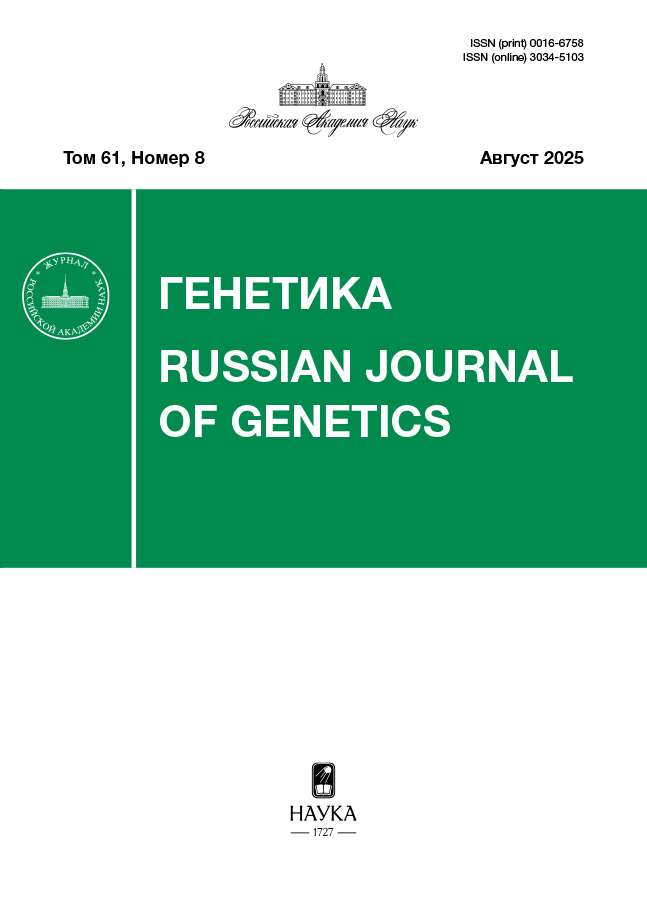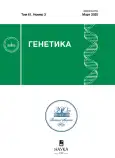Структура популяций коз Урала и центрального региона России на основе ядерных и митохондриальных маркеров
- Авторы: Солошенкова Э.А.1, Пискунов А.К.1, Воронкова В.Н.1, Коноров Е.А.1, Столповский Ю.А.1
-
Учреждения:
- Институт общей генетики им. Н.И. Вавилова Российской академии наук
- Выпуск: Том 61, № 3 (2025)
- Страницы: 40-52
- Раздел: ГЕНЕТИКА ЖИВОТНЫХ
- URL: https://gynecology.orscience.ru/0016-6758/article/view/679420
- DOI: https://doi.org/10.31857/S0016675825030051
- EDN: https://elibrary.ru/ULMCCG
- ID: 679420
Цитировать
Полный текст
Аннотация
Популяционно-генетические исследования доместицированных видов предоставляют информацию об истории вида и современном состоянии генетических ресурсов. Коза является одним из первых доместицированных человеком видов животных, широко используемых в сельском хозяйстве, а также представляет интерес в качестве объекта популяционных исследований. Для вида характерно высокое биоразнообразие, представленное аборигенными и трансграничными породами. В нашей стране большинство коз содержится в малых частных хозяйствах, в которых животные не подвергались жесткому прессу искусственного отбора и фактически являются уникальным объектом для исследования. В отличие от породистых пуховых коз, популяции которых расположены у южных и юго-восточных границ страны, генетическое разнообразие животных из основной, центральной части страны ранее не было охарактеризовано. На научной станции ИОГен РАН “Шаховская” была сформирована популяция на основе животных, содержащихся традиционным способом в частных хозяйствах в сельской местности на границе Московской, Тверской и Смоленской областей. В настоящей статье проведен популяционно-генетический анализ данной популяции и популяций из двух горнозаводских районов Урала, а также проведено сравнение их с существующими заводскими породами различного направления продуктивности.
Ключевые слова
Полный текст
Об авторах
Э. А. Солошенкова
Институт общей генетики им. Н.И. Вавилова Российской академии наук
Автор, ответственный за переписку.
Email: nickolaevaelina@gmail.com
Россия, Москва, 119991
А. К. Пискунов
Институт общей генетики им. Н.И. Вавилова Российской академии наук
Email: nickolaevaelina@gmail.com
Россия, Москва, 119991
В. Н. Воронкова
Институт общей генетики им. Н.И. Вавилова Российской академии наук
Email: nickolaevaelina@gmail.com
Россия, Москва, 119991
Е. А. Коноров
Институт общей генетики им. Н.И. Вавилова Российской академии наук
Email: nickolaevaelina@gmail.com
Россия, Москва, 119991
Ю. А. Столповский
Институт общей генетики им. Н.И. Вавилова Российской академии наук
Email: nickolaevaelina@gmail.com
Россия, Москва, 119991
Список литературы
- Афанасьева А.И. Гормональные механизмы сезонных адаптивных изменений у коз горноалтайской пуховой породы // Сибирский вестник сельскохозяйственной науки. 2005. № 4. С. 121–125.
- Zobel G., Neave H.W., Webster J. Understanding natural behavior to improve dairy goat (Capra hircus) management systems // Translational animal science. – 2019. V. 3. № 1. С. 212–224.
- Феофилов А.В., Юлдашбаев Ю.А., Глазко В.И. Доместикации сельскохозяйственных животных // Новости науки Казахстана. 2014. № 1. С. 84–99.
- Глазко В.И., Косовский Г.Ю., Глазко Т.Т. Доместикация как генетический феномен // Кролиководство и звероводство. 2018. № 1. С. 5–8.
- Dubeuf J.P., Morales F.A.R., Guerrero Y.M. Evolution of goat production systems in the Mediterranean basin: Between ecological intensification and ecologically intensive production systems // Small Ruminant Research. 2018. V. 163. P. 2–9.
- Liu M., Zhou Y., Rosen B.D. et al. Diversity of copy number variation in the worldwide goat population // Heredity. 2019. P. 636–646. https://doi.org/10.1038/s41437-018-0150-6
- Colli L., Milanesi M., Talenti A. et al. Genome-wide SNP profiling of worldwide goat populations reveals strong partitioning of diversity and highlights post-domestication migration routes // Genet SelEvol. 2018. P. 1–20. https://doi.org/10.1186/s12711-018-0422-x
- Бекетов С.В., Пискунов А.К., Воронкова В.Н. и др. Генетическое разнообразие и филогения пуховых коз Центральной и Средней Азии // Генетика. 2021. Т. 57. № 7. С. 810–819.
- Шаталов В.А. Этапы развития молочного козоводства в России // Овцы, козы, шерстяное дело. 2012. № 4. С. 17–20.
- Чикалев А.И. Козоводство: учебник: для вузов по направлению подготовки 111100 “Зоотехния” (бакалавриат). ГЭОТАР-Медиа. 2012.
- Воронкова В.Н., Пискунов А.К., Николаева Э.А. и др. Гаплотипическое разнообразие монгольских и тувинских пород коз (Caprahircus) на основе полиморфизма мтДНК и Y-хромосомы // Генетика. 2021. Т. 57. № 10. С. 1164–1173. https://doi.org/10.31857/S0016675821100155.
- Adamack A.T., Gruber B. PopGenReport: Simplifying basic population genetic analyses in R // Methods in Ecology and Evolution. 2014. V. 5. № 4. P. 384–387.
- Jombart T. Adegenet: An R package for the multivariate analysis of genetic markers // Bioinformatics. 2008. V. 24. № 11. P. 1403–1405.
- Peakall R.O.D., Smouse P.E. GENALEX 6: Genetic analysis in Excel. Population genetic software for teaching and research // Mol. Ecol. Notes. 2006. V. 6. № 1. P. 288–295.
- Luikart G., Gielly L., Excoffier L. et al. Multiple maternal origins and weak phylogeographic structure in domestic goats // Proc. Natl Acad. Sci. USA. 2001. V. 98. № 10. P. 5927–5932. https://doi.org/10.1073/pnas.091591198
- Waki A., Sasazaki S., Kobayashi E., Mannen H. Paternal phylogeography and genetic diversity of East Asian goats // Anim. Genet. 2015. V. 46. № 3. P. 337–339. https://doi.org/10.1111/age.12293
- Vidal O., Drögemüller C., Obexer-Ruff G. et al. Differential distribution of Y-chromosome haplotypes in Swiss and Southern European goat breeds // Sci. Rep. 2017. V. 7. № 1. P. 16161. https://doi.org/10.1038/s41598-017-15593-1
- Tabata R., Kawaguchi F., Sasazaki S. et al. The Eurasian Steppe is an important goat propagation route: A phylogeographic analysis using mitochondrial DNA and Y-chromosome sequences of Kazakhstani goats // Anim. Sci. J. 2018. V. 90. P. 317–322. https://doi.org/10.1111/asj.13144
- Chen C., Lu B., Huang X. et al. sangeranalyseR: simple and interactive analysis of Sanger sequencing data in R // bioRxiv. 2020.
- Okonechnikov K., Golosova O., Fursovet M. et al. Unipro UGENE: A unified bioinformatics toolkit // Bioinformatics. 2012. V. 28. № 8. P. 1166–1167.
- Kumar S., Tamura K., Nei M. MEGA: molecular evolutionary genetics analysis software for microcomputers // Bioinformatics. 1994. V. 10. № 2. P. 189–191.
- Excoffier L., Laval G., Schneider S. Arlequin (version 3.0): An integrated software package for population genetics data analysis // Evol. Bioinformatics. 2005. V. 21. P. 117693430500100003.
- Rozas J., Ferrer-Mata A., Sánchez-DelBarrio K. et al. DnaSP 6: DNA sequence polymorphism analysis of large data sets // Mol. Biol. Evol. 2017. V. 34. № 12. P. 3299–3302.
- Huelsenbeck J.P., Ronquist F. MRBAYES: Bayesian inference of phylogenetic trees // Bioinformatics. 2001. V. 17. № 8. P. 754–755.
- Lanfear R., Frandsen P.B., Wright A.M et al. PartitionFinder 2: New methods for selecting partitioned models of evolution for molecular and morphological phylogenetic analyses // Mol. Biol. Evol. 2017. V. 34. № 3. P. 772–773.
- Leigh J.W., Bryant D. POPART: Full-feature software for haplotype network construction // Methods Ecol. Evol. 2015. V. 6. № 9. P. 1110–1116.
- Kamvar Z.N., Tabima J.F., Grünwald N.J. Poppr: An R package for genetic analysis of populations with clonal, partially clonal, and/or sexual reproduction // Peer J. 2014. V. 2. P. e281.
- Cassidy L.M., Teasdale M.D., Carolan S. et al. Capturing goats: Documenting two hundred years of mitochondrial DNA diversity among goat populations from Britain and Ireland // Biol. Letters. 2017. V. 13. № 3. P. 20160876.
- Al-Araimi N.A., Al-Atiyat R.M., Gaafar O.M. et al. Maternal genetic diversity and phylogeography of native Arabian goats // Livestock Sci. 2017. V. 206. P. 88–94.
- Ruo-Yu L.I.U., Gong-She Y., Chu-Zhao L.E.I. The genetic diversity of mtDNA D-loop and the origin of Chinese goats // Acta Genetica Sinica. 2006. V. 33. № 5. P. 420–428.
- Bandelt H.J., Forster P., Röhl A. Median-joining networks for inferring intraspecific phylogenies // Mol. Biol. Evol. 1999. V. 16. № 1. P. 37–48.
- Mukhina V., Svishcheva G., Voronkova V.N. et al. Genetic diversity, population structure and phylogeny of indigenous goats of mongolia revealed by SNP genotyping // Animals. 2022. V. 12. P. 221.
Дополнительные файлы















